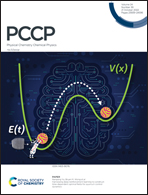31P spin–lattice and singlet order relaxation mechanisms in pyrophosphate studied by isotopic substitution, field shuttling NMR, and molecular dynamics simulation†
Abstract
Nuclear spin relaxation mechanisms are often difficult to isolate and identify, especially in molecules with internal flexibility. Here we combine experimental work with computation in order to determine the major mechanisms responsible for 31P spin–lattice and singlet order (SO) relaxation in pyrophosphate, a physiologically relevant molecule. Using field-shuttling relaxation measurements (from 2 μT to 9.4 T) and rates calculated from molecular dynamics (MD) trajectories, we identified chemical shift anisotropy (CSA) and spin–rotation as the major mechanisms, with minor contributions from intra- and intermolecular coupling. The significant spin–rotation interaction is a consequence of the relatively rapid rotation of the –PO32− entities around the bridging P–O bonds, and is treated by a combination of MD simulations and quantum chemistry calculations. Spin–lattice relaxation was predicted well without adjustable parameters, and for SO relaxation one parameter was extracted from the comparison between experiment and computation (a correlation coefficient between the rotational motion of the groups).



 Please wait while we load your content...
Please wait while we load your content...
